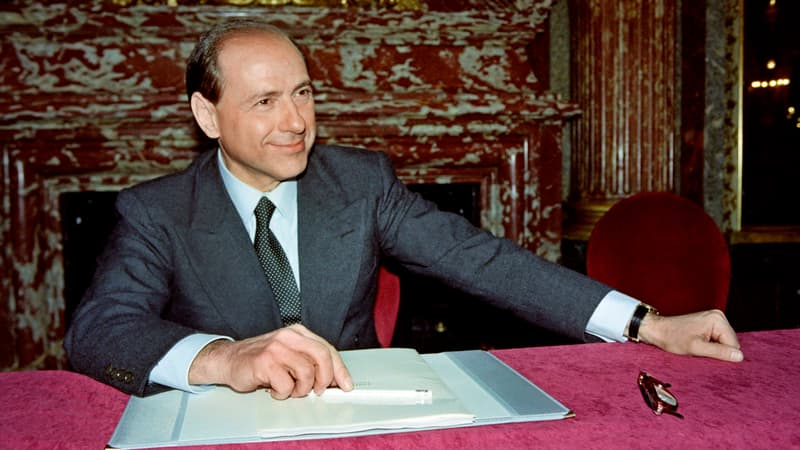A clash of cultures and a strange political calculation. In this autumn of 1985, the socialist government grants a public service concession for 18 years to the company France 5 for the exploitation of the fifth nationally broadcast hertzian television channel. A few months later, the La Cinq channel became the second private channel to broadcast in France after Canal+.
One year into the encrypted cultural subscription channel, it’s time for the wildly popular, sequined Five by one Silvio Berlusconi. Already king of the small screen in Italy, where he is nicknamed “Sua Emittenza” (a mixture of “his eminence of him” and “his transmitter of him”), the Milanese billionaire wants to extend his audiovisual empire to Europe. It will be Telefünf in Germany, Telecinco in Spain and therefore La Cinq in France.
He joined forces with businessman Jérôme Seydoux (who would become the boss of Pathé a few years later) and managed to convince President François Mitterrand to entrust him with the coveted frequency. On paper, everything contrasts with the head of the socialist state, a lover of literature, and the Italian Pope from “Coca Cola TV”, a fervent anti-communist who will enter politics a few years later under the banner of Forza Italia. a right-wing populist party.
An industrialist and intellectuals
But in business as in politics, alliances have no smell. Especially since ‘Il Cavaliere’ is very well surrounded.
Especially since the businessman already has a long arm. Berlusconi, close to the Italian socialist power at the time, managed to convince Bettino Craxi, president of the Council and head of the PSI, to whisper his name to the French head of state. The latter, who loves nothing less in the business world than self made men (Bernard Tapie will enter the socialist government in 1992) – agrees to entrust the new channel to the Italian.
A few months before the 1986 legislative elections, which he knows how to lose, François Mitterrand does not want to leave the full powers of the audiovisual sector to the right of Jacques Chirac. At the time, all the major channels (including TF1) were public and would likely be a springboard for the RPR for the future presidential campaign of 1988. The president wanted to keep an ace up his sleeve with a channel that could, wait, if necessary. , to be a communication relay for the PS.
A parliamentary battle then ensued between the Socialist majority, which wanted to install a transmitter on the Eiffel Tower that would, in particular, allow La Cinq to be broadcast, and the RPR opposition, including the president and the mayor of Paris, Jacques Chirac, who oppose.
The stars paid four times more than in TF1
The transmitter was installed in vain and on February 20, 1986 the channel (with a significant budget for the time of 50 million francs) began to broadcast its programs. The inaugural program “Voilà la Cinq” is hosted by stars of the small screen stolen at exorbitant prices (four times their previous salary) from French public channels. That night, it was Christian Morin, Roger Zabel and Alain Gillot-Pétré who received the biggest stars of the French variety (Johnny Hallyday, Serge Gainsbourg and Mireille Mathieu).
Variety shows, shocking political debates but also Japanese cartoons (olive and tom, princess sarah…), American series like arnold and willy, star trek EITHER dallas bought by Berlusconi doubling the rights paid by TF1… The channel spends lavishly. Especially since, an exorbitant concession of power, it has the right to broadcast 250 films a year and this, only two years after its premiere (compared to three for the channels at that time).
But La Cinq’s triumph will be short-lived. Coming to power in 1986, Jacques Chirac’s right wing put a spoke in the wheels of the “François Mitterrand chain”. The Cinq will never have as many stations as its rivals TF1, Antenne 2 and FR3, it loses the right to broadcast films and, above all, the concession of public service is questioned.
Channel ratings remained good and progressed to a record high in 1989 at the time of the fall of the Berlin Wall with over 13% market share. Insufficient, however, to justify the significant spending desired by Berlusconi. The latter opposes the press officer Robert Hersant, who joined the La Cinq adventure in 1987, who judges that the Italian is paying too much for his American programs. In return, Berlusconi believes that the information takes up too much space in the air.
Liquidated in April 1992
Crushed under an accumulated debt of 3,500 million francs (840 million current euros), Berlusconi decides to throw in the towel. He sells the rights to the Japanese cartoons to the company AB Production, which will mark the heyday of TF1 and Club Dorothée. Under political pressure, competition from other channels united against it, declining audiences and revenue, La Cinq was liquidated in April 1992.
Silvio Berlusconi leaves France. He will only return to it in the 2000s with the acquisition of the magazine press group Emap by the Mondadori subsidiary of his Fininvest media group. The Closer and Grazia magazines will be the locomotives of a press group that the Italian businessman will end up selling in 2019 to the French company Reworld. But for Berlusconi, who has meanwhile savored football with AC Milan and especially politics, France will never again be a land of conquest. The book closed for good on April 12, 1992, with a black screen.
Source: BFM TV


